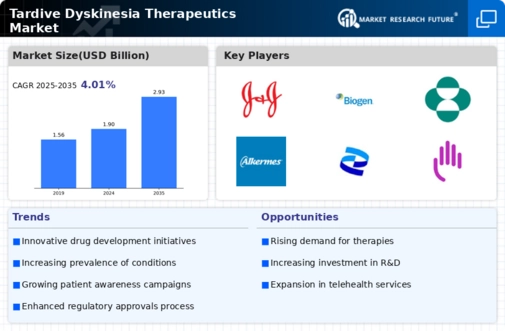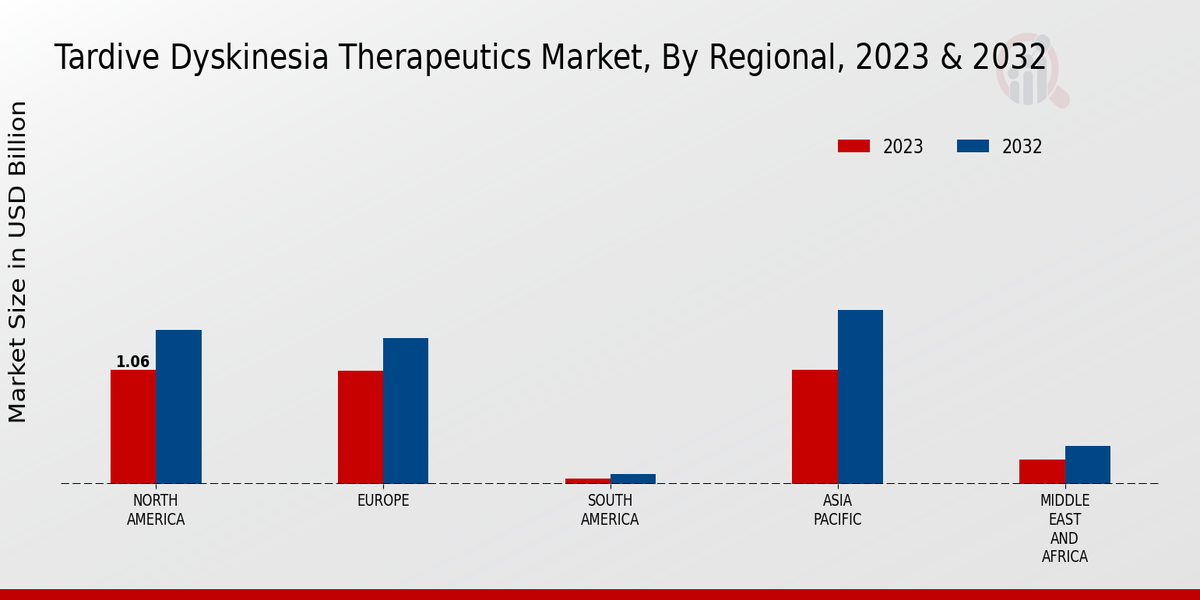Market Growth Projections
The Global Tardive Dyskinesia Therapeutics Market Industry is projected to experience substantial growth over the coming years. With a market valuation of 1.9 USD billion in 2024, it is expected to reach 2.93 USD billion by 2035, reflecting a compound annual growth rate of 4.03% from 2025 to 2035. This growth trajectory is influenced by various factors, including the rising prevalence of tardive dyskinesia, advancements in treatment options, and increased awareness among healthcare providers and patients. The market's expansion is indicative of the ongoing efforts to address the therapeutic needs of individuals affected by this condition.
Rising Awareness and Diagnosis
Heightened awareness of tardive dyskinesia among healthcare professionals and patients is fostering an environment conducive to growth in the Global Tardive Dyskinesia Therapeutics Market Industry. Educational initiatives and campaigns aimed at improving recognition of the disorder are leading to earlier diagnosis and treatment. As awareness increases, more patients are likely to seek medical advice, resulting in a higher number of diagnosed cases. This trend is expected to drive demand for therapeutics, as timely intervention can mitigate the severity of symptoms. Consequently, the market is poised for expansion, with projections indicating a valuation of 1.9 USD billion in 2024.
Advancements in Treatment Options
Innovations in the development of therapeutics for tardive dyskinesia are significantly influencing the Global Tardive Dyskinesia Therapeutics Market Industry. New medications, such as VMAT2 inhibitors, have shown promise in reducing symptoms and improving patient quality of life. The introduction of these advanced therapies is likely to enhance treatment adherence and patient outcomes. As more effective options become available, healthcare providers are expected to adopt these therapies, further driving market growth. The anticipated compound annual growth rate of 4.03% from 2025 to 2035 reflects the potential impact of these advancements on the overall market landscape.
Growing Investment in Mental Health
The increasing focus on mental health and associated disorders is driving investment in the Global Tardive Dyskinesia Therapeutics Market Industry. Governments and private organizations are allocating more resources to address mental health issues, including tardive dyskinesia. This trend is reflected in funding for research initiatives and the development of new treatment modalities. As investment in mental health rises, the availability of effective therapeutics for tardive dyskinesia is expected to improve, thereby enhancing patient care. The anticipated growth rate of 4.03% from 2025 to 2035 underscores the potential for market expansion fueled by this increased investment.
Regulatory Support for New Therapies
Supportive regulatory frameworks for the approval of new therapeutics are playing a crucial role in shaping the Global Tardive Dyskinesia Therapeutics Market Industry. Regulatory agencies are increasingly expediting the review process for innovative treatments, recognizing the unmet medical needs of patients with tardive dyskinesia. This regulatory environment encourages pharmaceutical companies to invest in research and development, leading to a more robust pipeline of potential therapies. As new treatments gain approval, the market is likely to experience accelerated growth, contributing to the projected increase from 1.9 USD billion in 2024 to 2.93 USD billion by 2035.
Increasing Prevalence of Tardive Dyskinesia
The rising incidence of tardive dyskinesia, particularly among patients undergoing long-term antipsychotic treatment, is a primary driver for the Global Tardive Dyskinesia Therapeutics Market Industry. As the population ages and mental health disorders become more prevalent, the number of individuals affected by this condition is expected to grow. Current estimates indicate that approximately 20% of patients on antipsychotic medications may develop tardive dyskinesia, leading to an increased demand for effective therapeutic options. This trend is likely to contribute to the market's projected growth, with a valuation of 1.9 USD billion in 2024 and an anticipated rise to 2.93 USD billion by 2035.






















Leave a Comment